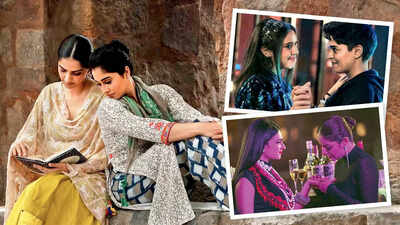ARTICLE AD BOX

For Aryan, a clinical psychologist in Reema Kagti’s docu-series In Transit, the awareness that he's a trans-man came from watching the popular TV show Hum Paanch (1995-2006). For him, Kajal bhai was the first indication that a woman could identify as a man.
"I am so grateful to whoever thought of that character because otherwise, I would not have got that confidence that this is possible," he says.This quiet moment is a powerful reminder of how films and television can reflect and reshape the world we live in. Queer representation in Indian cinema has come a long way, echoing the shifts in public perception, raising awareness, and the growing assertion of LGBTQIA+ identities.From being reduced to the butt of jokes to finally being heard, Indian cinema’s journey toward queer representation is not just creative progress - it’s a lifeline for many.'Negative portrayals have reduced'“What has definitely changed is that negative portrayals have reduced. A film like Dostana would face major backlash today,” says queer digital content creator Prarthana Prasad. “Positive portrayals are just beginning.”
Films such as Ek Ladki Ko Dekha Toh Aisa Laga, Kaathal: The Core, and Aligarh have moved away from mockery and stereotypes, offering layered characters and sensitive storytelling. OTT platforms, in particular, have played a pivotal role.

Jyothika-Mammootty’s Kaathal: The Core placed LGBTQ+ narratives front and centre.
“Ek Ladki Ko... made a difference to a lot of people’s lives," says its writer and trans-woman Ghazal Dhaliwal. "There was an Indo-American girl whose father hadn’t spoken to her for eight years after she came out to him.
He watched the film and reconnected with her. That message made it all worthwhile."Kalki Koechlin received a similar response for her film Margarita with a Straw, which portrayed a bisexual woman with cerebral palsy. "So many people I know came after the screening and told us how they brought their mum or their dad and explained that they were queer," she said in an interview.'Cinema is a great tool to begin the dialogue'“If you show a 16-year-old struggling with their sexuality, or a queer character who becomes a famous painter or Prime Minister — that could be the one reason they don’t kill themselves.
Cinema has that power,” says Vidur Sethi, who uses they/them pronouns and plays the lead in Onir’s recent gay love story Pine Cone.Beyond emotional resonance, films can also serve as conversation starters at home. Prarthana Prasad adds, “A few queer people told me they used films as a way to start a conversation with their parents. It’s a great tool to begin that dialogue.”Filmmaker Sridhar Rangayan echoes this, recalling the impact of his 2019 film Evening Shadows, which follows a young man coming out to his mother in rural India.
“That became a sort of guidebook for mothers to understand their child,” he says. “We received thousands of messages from across India, and also across the world, from both parents and LGBTQ+ children about how the film helped them navigate their coming out journeys.
”

A still from Made In Heaven.
Zoya Akhtar and Reema Kagti’s Made in Heaven drove home the message that there is nothing wrong in being gay. In one of the most powerful moments, the gay protagonist, Karan’s landlord is confronted by his daughter, Mitali, who finds out he installed a spy camera in Karan’s bedroom.
Standing up for Karan, she tells her father, “It’s normal. There’s nothing disgusting about being gay.”Representation also gains strength when backed by nuanced performances. Nilakshi Roy, a member of the queer parent group Sweekar: The Rainbow Parents, points to Konkona Sensharma in Geeli Puchhi and Mammootty in Kaathal: The Core as standout examples. “It was done in a restrained, mature, magnificent way - the way such stories deserve to be told.
A powerful, dignified portrayal. It’s not just about the story being mainstream, but about a mainstream actor playing a queer role.
That, too, is a very positive thing.”
Let alone whether it’s good or bad to be gay or lesbian—at least now people know the concept exists. That itself is a positive change.
-Prarthana Prasad
Since the landmark 2018 Supreme Court verdict that decriminalised homosexuality by reading down Section 377 of the Indian Penal Code, there has been a rise in queer stories in Indian cinema and streaming platforms. Films like Ek Ladki Ko Dekha Toh Aisa Laga (2019), Shubh Mangal Zyada Saavdhan (2020), Chandigarh Kare Aashiqui (2021), and Badhaai Do (2022) have placed LGBTQ+ narratives front and centre.The shift has been even more visible on OTT platforms. Shows like Made in Heaven, Mismatched, The Royals, Class, and Modern Love Mumbai have included complex, emotionally layered queer characters.'We need more space behind the camera'

Queer digital content creator Prarthana Prasad shares, “A few queer people told me they used films as a way to start a conversation with their parents. It’s a great tool to begin that dialogue.”
Vidur notes, "More and more queer people are coming into films," and that space is being created bit by bit, though "there’s a long way to go." While queer actors like Ivanka Das (Bombay Begums), Trinetra Haldar (Made In Heaven), Lauren Robinson (Mismatched), and Sushant Divgikar are redefining what it means to be 'seen' on screen, there are also dedicated efforts to amplify queer voices behind the camera.
Meaningful change requires looking behind the screen
Monika Shergill, Vice-President, Content, Netflix India
“Meaningful change also requires looking behind the screen,” says Monika Shergill, Vice-President, Content, Netflix India. "When queer stories are told—whether at the centre or woven into the backdrop of a larger world—they begin to mirror the diversity of real life. That resonance has an effect: it prompts reflection, starts conversations, and over time, helps shift how people perceive one another," she adds.
QueerFrames, launched in 2023 by The Queer Muslim Project with support from the Netflix Fund for Creative Equity, is one of the few dedicated creative incubators for queer storytellers across South Asia.

Monika Shergill, Vice-President, Content, Netflix India.Monika Shergill, Vice-President, Content, Netflix India believes "authentic stories come from authentic spaces."
“Initiatives like Queer Frames, our screenwriting lab for underrepresented queer storytellers, and Voices of Tomorrow, which brings LGBTQIA+ talent into India’s dubbing and voice landscape, are part of that effort.
We believe authentic stories come from authentic spaces,” adds Monika.'Let queer people tell their own stories'As queer characters begin to find space in Indian cinema, a growing call within the community is for space to be extended behind the scenes - where stories are conceived, written, and crafted.Representation alone isn’t enough, many believe. “They should let queer people tell their own stories,” says Prasad.
“Representation is there, but it needs to get better.”Sushant Divgikar, actor and drag performer, points out that it’s not just about who we see on screen, but who is shaping what we see. "You need more queer directors, producers, writers, cinematographers who understand the intricacies in detail.”

Sushant Divgikar says, "A trans person should be allowed to play a man, woman, trans, a tree, a sofa. Anything. An actor is an actor."
Casting, too, is often limiting, and Sushant challenges this mindset with a characteristic clarity, “A trans person should be allowed to play a man, woman, trans, a tree, a sofa.
Anything. An actor is an actor.”The consensus is clear: visibility must come with agency. Only then can queer stories truly reflect the complexity and dignity of the lives they aim to portray.
Queer stories have just begun to shine-please let the rainbows rise and glow
- Sridhar Rangayan, queer filmmaker & activist
'A lot of queer storytelling is still about pain and trauma'As queer narratives find more space on Indian screens, people from the community are asking: why are most of these stories still steeped in pain?“If you always show the most sad and difficult sides of queer life, it might be realistic—but not inspiring,” says Prarthana.
“We need to move beyond just coming-out stories and tortured love angles.”

Actor Vidur Sethi plays the lead role in Onir's Pine Cone.
Vidur Sethi agrees. They want to see queer characters being celebrated not for their pain, but for their potential. “I don’t want to only see trauma. I want to see a queer person be intelligent, successful, have a career, and juggle personal life—just like any other human.”
Sushant Divgikar is even more direct, "Please stop with all these love stories. Let’s see stories where a trans person becomes an inspector, a doctor, a lawyer. That’s what we need—empowering stories.”



.png)
.png)
.png)
















 3 hours ago
4
3 hours ago
4









 English (US) ·
English (US) ·